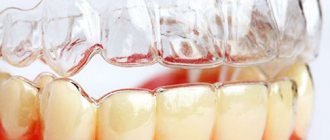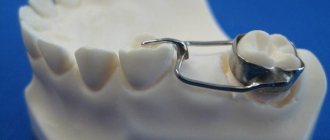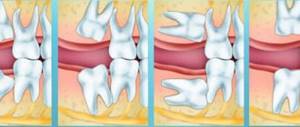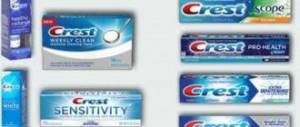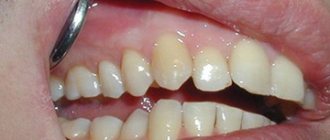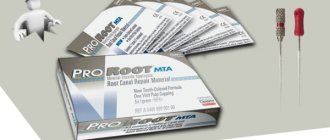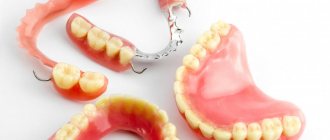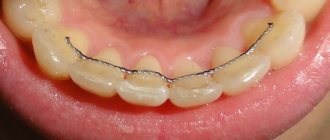A little about bruxism. Why can’t you do without a mouth guard with such a diagnosis?
Bruxism is a disease in which a person clenches their jaws tightly and cannot control the force of their teeth closing.
The problem especially manifests itself at night, when a person is sleeping and does not control the jaw muscles. As a result of such pressure, the teeth are not just worn down, but loosened, the bite is damaged, against which more global dental problems arise, including destruction of the temporomandibular joint. No one is immune from bruxism; the disease can occur:
- due to sleep problems;
- due to increased nervousness;
- against the background of bad habits;
- due to problems with the gastrointestinal tract, etc.
It is important! If left untreated, the disease can lead to serious discomfort, dental problems, and sleep apnea - a pathological breathing disorder during sleep, which is also accompanied by snoring.
How is bruxism treated?
If a problem occurs, you should contact an orthodontist. He will select a special mouth guard to wear while you sleep. It is an elastic dental splint made of biocompatible plastic. This orthodontic design responds to the load when the patient compresses the dentition, preventing the chewing muscles from overexerting. As a result, the lower jaw relaxes and muscle hypertonicity goes away. Treatment will be effective if you wear the mouth guard for at least 10 hours a day.
What tasks does the mouthguard cope with?
A dental mouthguard also performs the following tasks:
- an individual mouthguard provides prevention of dental misalignment;
- helps maintain the integrity of the enamel, and, therefore, reduce the likelihood of developing caries;
- reduces the risk of developing the consequences of bruxism, namely, headaches, pain in the projection of the jaw, which can radiate to the back and neck.
Dentistry for those who love to smile
+7
Make an appointment
Custom mouthguards for bruxism
These are orthodontic structures that are made in a dental laboratory based on impressions of the jaw of a particular patient. They are used in severe cases of the disease, when the symptoms of bruxism are significantly pronounced and serious correction of the dentition is required. The more accurately the design is selected, the more effectively it affects the jaw muscles. Usually, after the patient puts on a dental guard, 10-15 minutes are enough for the muscle spasm to go away and the headache or neck pain to subside. The downside of these structures is that they take quite a long time to produce - up to several weeks, and the patient often needs to start treatment as soon as possible.
Night aligners and aligners - what's the difference?
Night aligners also act as a kind of protective structures against pathological involuntary clenching of the jaws during sleep. However, their main function is orthodontic.
Night dental aligners are used for:
- correction of minor bite pathologies;
- strengthening dental units - for example, when using mouth guards with the effect of enamel remineralization. A gel is placed inside the silicone pad, which has a beneficial effect on the enamel;
- consolidation of the result after orthodontic treatment - as a rule, after wearing braces, orthodontists recommend wearing aligners at night for about 6 months.
What to do
First of all, having established a diagnosis, the dentist will advise you to buy a night guard for your teeth. In St. Petersburg, this can be done in almost all dental clinics and private offices.
There are 3 types of caps:
- daytime (used if the patient cannot control spasms during the day. The device looks aesthetically pleasing, almost invisible when smiling or talking);
- nightwear (dressed for the night);
- resonating (such designs belong to protective and at the same time therapeutic devices).
The named types are divided into:
- thermoplastic;
- standard;
- individual.
The main criterion for the quality of a mouthguard is its tight fit to the surface of the teeth.
Night guards for teeth abrasion
There is a pathology called bruxism. This is involuntary grinding of teeth, which causes abrasion of tooth enamel. The reasons for the development of bruxism can be very diverse. Grinding your teeth at night causes the enamel to wear away and the tooth to become vulnerable. An anti-grinding mouth guard at night will protect you from such influences. Anti-bruxism mouthguards are placed in the mouth at night. These pads are made from biopolymers. They are worn on both the lower and upper teeth. When the jaws are clenched, the mouthguard blocks the closure of the teeth, so the enamel does not wear off. Such an orthodontic device also performs other functions:
- Reducing the load on the articular head.
- Reduce muscle pain.
- Blocking jaw deformities.
- Mouthguards do not allow dental units to move.
- Prevents the bite from developing abnormalities.
- Uniform load distribution.
If you grind your teeth while you sleep, there is a chance that this can lead to wear and tear of the enamel. Therefore, it is worth visiting an orthodontist.
When are they appointed?
Night guards of this type are prescribed for:
- complaints of teeth grinding;
- complicated grinding.
Such structures reliably protect teeth from abrasion and further destruction.
Mouthguards are not prescribed for serious mental disorders.
Kinds
Aligners for bruxism can be used during the day or night. People who suffer from muscle spasms cannot control the spasms even when conscious. Since grinding your teeth is unpleasant, you should consider wearing a special mouth guard. Night models that eliminate bruxism are more rigid than products designed to be worn during the day. For this reason, they are removed during the daytime. To treat bruxism, mouthguards are made individually using casts. It must be worn at night. A mouthguard for teeth at night is mainly made of special silicone, which does not cause allergic reactions. The production time for overnight dental guards against bruxism is a maximum of five days. The product perfectly eliminates rattles. It can be worn either on one or both jaws at once.
How are mouth guards made for teeth grinding?
The manufacture of these structures is carried out in special laboratories. For this purpose, modern high-quality polymers are used. They are resistant to mechanical and chemical influences and also have a long service life. Such materials can have different colors - from transparent to any bright shades.
To custom make a structure for bruxism, a specialist must first make an impression of the patient’s jaw. This is necessary in order to see the exact location of the jaw, as well as to note all the irregularities of the dentition. Thanks to this, you can make a model that exactly matches the surface of the teeth and will not cause discomfort while wearing.
Production time
The time required to manufacture the structure depends on the material used, as well as on the structural features of the patient’s dentition. There are cases when, after fitting, the doctor identifies certain inconsistencies that also need to be eliminated.
Usually it is possible to make a high-quality structure for the treatment of bruxism in 1-1.5 weeks. If there are serious violations, the dentist may recommend urgent production.
Important! The period required to manufacture the structure should be taken into account when ordering a second copy. Since there can be no pauses in therapy, it is better to order it even before the first one becomes unusable.
Custom sports mouth guards
Sports mouthguards are necessary to protect teeth, as well as hard and soft tissues of the face from mechanical injuries. They optimally distribute the load resulting from blows, and thereby prevent serious injuries - jaw fractures, displacement of the mandibular joint, damage to the cervical spine, concussion, etc.
Like mouthguards for orthodontic treatment, they come in three types - standard, thermoplastic and customized.
Despite the fact that standard mouthguards are produced in three sizes, they still cannot fully protect the athlete’s dental system, since they have many disadvantages. Therefore, dentists are unanimous in their opinion: standard mouthguards are useless, since they do not take into account the individual characteristics of the oral cavity.
Thermoplastic mouthguards are not much better than standard models. They are poorly fixed and, moreover, are not strong enough to become full-fledged protection. Due to increased loads, such material will quickly begin to deform and collapse.
The ideal way out of this situation is individual mouthguards. They accurately repeat the relief of the oral cavity, as well as all the anatomical features of the jaw and dentition, due to which maximum protection will be ensured. At the same time, a custom-made sports mouth guard is very comfortable to wear. It will not impede breathing or diction.
There are several types of sports mouth guards:
· single-layer (light) – intended for children, youth, as well as for fitness classes;
· double-layer (semi-professional) – used for non-contact sports;
· three-layer (professional) – necessary in sports with direct contact;
· hard three-layer (elite) – suitable for all sports.
In addition, there is another model of sports mouthguards - for braces. It protects the structure, teeth and soft tissues from mechanical damage and injury. Thanks to her, you don’t have to give up activities due to the need for orthodontic treatment or the use of braces, preferring sports.
Advantages and disadvantages
The main advantage of these structures for bruxism is their ease of use. Such plates do not need to be attached to the teeth or installed using additional crowns. They can be used even in the absence of a certain number of teeth in the dentition.
At the right time, the patient can independently install the structure. It is very easy to care for her. It does not require the use of additional orthodontic instruments or medications. You can also remove it at any time necessary. You don't need to visit a doctor for this.
Another plus is the availability of a wide variety of multi-colored models for the youngest patients. Many of them are afraid of carrying a foreign body in their mouth. However, designs decorated with original drawings arouse children’s interest and the treatment process for bruxism becomes more enjoyable and easier.
The main disadvantages of using mouth guards include the discomfort they cause in the patient during the first period of wearing. Usually, it takes about a week for a person to get used to the design. But, given that in most cases these plates need to be worn only at night, this disadvantage becomes insignificant.
Disadvantages of custom mouth guards
· Price. This is the most expensive type of mouthguards, since they are made individually using computer modeling. During the production process, high-quality biocompatible material that does not cause allergies is used.
· Long production time. Unlike standard mouthguards, which can be put on right away, a custom design takes some time to create.
Application Guide
The intraoral appliance must be worn at night. There is no justification for wearing it during the day. It will make it difficult to pronounce sounds and eat food. In addition, it is necessary to take into account that rhonchopathy develops exclusively during sleep.
This is interesting: Prevention of dental caries
The mouthguard is installed after hygienic cleansing of the oral cavity using antibacterial hygiene products. Such an event will help prevent putrefactive and inflammatory processes.
When using a removable prosthetic structure, the mouth guard is put on after the first one is removed from the oral cavity.
Self-installation is divided into several stages:
- treat the product with a disinfectant solution;
- dip in hot water (no more than 85 degrees) for 15 seconds;
- move the movable jaw forward slightly;
- using a special holder, place the device in the oral cavity;
- For a tight fit to the dental units, perform pressing manipulations along the entire plane of the product.
Remember! The mouthguard cannot lose its functions after it is heated and subsequently cooled.
Can I buy it at a pharmacy?
Thermoplastic and universal mouth guards are sold in pharmacies without a doctor's prescription. However, this is not the best option for getting rid of teeth grinding. They are poorly fixed on the jaw, break or become deformed from strong compression, and are short-lived.
Price
The price of a dental night guard varies depending on the material and manufacturing method. A pharmacy version of a regular mouthguard will cost from 2 to 2.5 thousand rubles, while one made from an individual impression costs more - from 5 to 10 thousand rubles per jaw.
Standard aligners can be easily purchased at a pharmacy or online store, but this option is not the most correct, since the aligner must fit tightly to the surface of the teeth, and standard aligners are not able to replicate the shape of the units. Dentists advise not to save money and go to the clinic to get an individual device.
Indications for use
Before buying a night guard, you should definitely consult with a dentist, who will not only determine the presence of indications, but will also help with choosing or manufacturing a suitable model. The use of elastic pads is recommended in the following cases:
- It is necessary to correct minor defects in the dentition or bite;
- There is a need to treat snoring, bruxism or TMJ hypertonicity;
- The patient moves on to the final stage of corrective treatment.
The desired effect can be achieved only with strict adherence to the prescribed plan, including the duration of daily wearing of the device.
Manufacturing and care
The algorithm for creating a night guard includes the following sequential stages:
- Comprehensive examination of the oral cavity, formation of impressions and development of a digital model, on the basis of which a treatment plan is drawn up;
- Laboratory production of corrector with subsequent heat treatment;
- Trying on the finished product and familiarizing yourself with the instructions.
Recommendations for caring for mouthguards require following simple rules. It is enough to regularly change the pads, keep them clean with regular rinsing in warm water and a soft bristle brush, and after removal, place them in a special container that prevents mechanical damage. In addition, it is important to adhere to the schedule for changing sets - especially when taking a correction course.
Indications and contraindications
The main indication for use is the presence of symptoms of bruxism in a person. It does not matter how often and intensely they manifest themselves. The use of such structures is absolutely safe, so it cannot bring any negative consequences.
The age of the patient also does not matter. Mouthguards are very actively used in pediatric dentistry. This is due to their great efficiency and ease of use. However, in this case it is important to remember that children, due to their nature, may deliberately remove the plate. Therefore, to ensure quality treatment, it is necessary to conduct explanatory conversations with them and monitor the implementation of recommendations.
Other indications for use include:
- deformations of the dentition of various types;
- presence of malocclusion;
- the gaps between the teeth are too large or, conversely, too small.
All these problems can occur against the background of bruxism symptoms. In this case, the mouthguard will have a complex purpose.
As for contraindications, they practically do not exist. The structures are made from safe materials; they are securely attached to the teeth and do not cause discomfort. However, if the patient has certain mental disorders, he may be denied a mouth guard. Epilepsy is especially dangerous in this case. During an attack, the patient may accidentally swallow the plate, after which it will block his airway, thereby causing suffocation.
